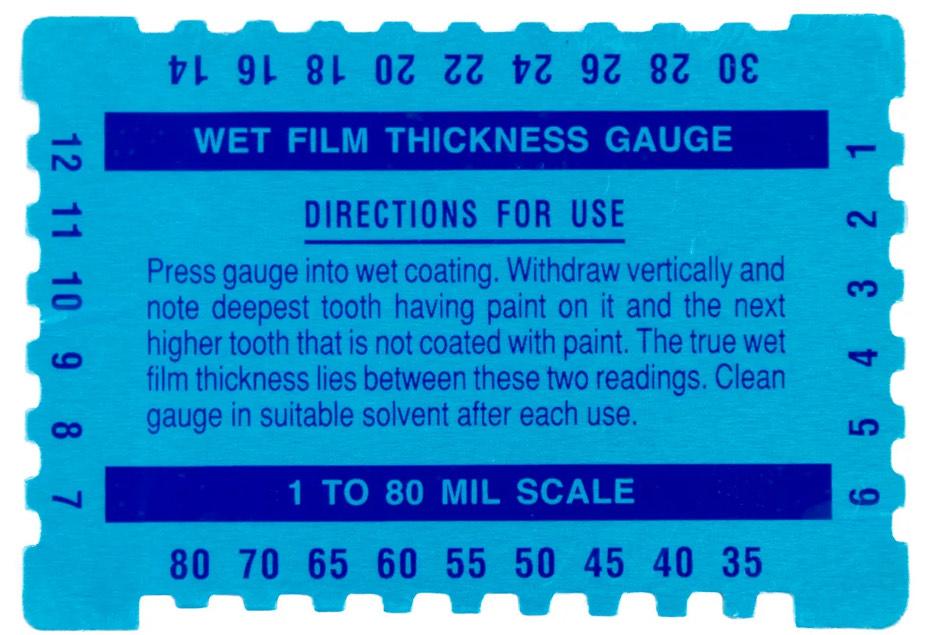Understanding Wet Film Thickness (WFT) and Dry Film Thickness (DFT)

In the paint and coatings industry, particularly in the specialized field of bathtub, tile, and countertop refinishing, precision and performance are paramount. One of the most crucial aspects of ensuring that a coating performs as intended is understanding and controlling its thickness. This brings us to two essential terms: Wet Film Thickness (WFT) and Dry Film Thickness (DFT). These units of measure are critical in gauging the performance of coatings, ensuring durability, and achieving the desired finish.
What is Wet Film Thickness (WFT)?
Wet Film Thickness (WFT) refers to the thickness of a coating immediately after it has been applied, before it has had the chance to dry or cure. WFT is typically measured in mils (one mil equals 1/1000th of an inch) or microns (one micron equals 1/1000th of a millimeter). Understanding WFT is vital for several reasons:
- Coverage Control: WFT determines how much area a certain volume of coating will cover. This is essential for cost estimation and ensuring that enough material is on hand for a project.
- Thickness Consistency: Achieving a uniform WFT ensures that the coating will cure evenly, without variations that could lead to weak spots, runs, or sags.
- Performance Specifications: Many high-performance coatings are formulated to work within specific WFT ranges to achieve optimal adhesion, durability, and appearance. Exceeding or not meeting the specified WFT can affect the coating’s performance.
What is Dry Film Thickness (DFT)?
Dry Film Thickness (DFT) is the thickness of a coating after it has dried or cured. DFT is often considered the most critical measurement in the coating process because it directly impacts the coating's performance and longevity. DFT is also measured in mils or microns, and its importance can be understood through the following points:
- Durability and Protection: DFT determines the coating’s ability to protect the substrate from environmental factors such as moisture, UV exposure, chemicals, and physical abrasion. A coating with an insufficient DFT may fail prematurely, leading to costly repairs or replacements.
- Compliance with Specifications: Many industry standards and regulations specify the required DFT for coatings in particular applications. Ensuring compliance is crucial for both performance and legal reasons.
- Aesthetic and Functional Integrity: DFT influences not only the protective properties of a coating but also its appearance and texture. Proper DFT ensures that the finish looks as intended without issues such as orange peel, pinholes, or blushing.
Why WFT and DFT are Important
Both WFT and DFT play vital roles in the success of a coating application:
- Quality Control: Monitoring WFT and DFT is a key component of quality control. By measuring and adjusting these thicknesses, applicators can ensure that the coating meets the specified requirements, leading to consistent and reliable performance.
- Material Efficiency: By knowing the WFT and how it translates to DFT, applicators can optimize material usage, reducing waste and ensuring that the coating is applied in the most efficient manner possible.
- Predictive Maintenance: In some applications, especially in industrial settings, monitoring DFT can help predict when a recoating might be necessary, aiding in preventive maintenance.
Measuring Wet Film Thickness (WFT)
WFT can be measured using a simple tool known as a wet film thickness gauge or comb gauge. This gauge has notches cut into its edges, each representing a specific thickness. To measure WFT:
- Apply the coating uniformly across the surface.
- Press the WFT gauge into the coating immediately after application.
- Remove the gauge and observe which notches are coated with paint and which are not.
- The thickness is determined by the highest notch that is coated and the next highest that is not.
Measuring Dry Film Thickness (DFT)
DFT is typically measured using a dry film thickness gauge, which often works based on magnetic or eddy current principles, depending on whether the substrate is ferrous or non-ferrous. To measure DFT:
- Ensure the coating is fully cured before measurement.
- Select the appropriate DFT gauge for the substrate material.
- Calibrate the gauge according to the manufacturer’s instructions.
- Place the probe of the gauge on the coated surface, and the device will display the DFT measurement.
For more advanced measurements, destructive testing methods can be used, where a small section of the coating is cut away to directly measure the cross-section.
** NOTE: Thicknesses are based on NO REDUCER. If you add reducer you must compensate for evaporation to achieve proper mil / micron mil thickness.
| Wet Film Thickness (WFT): | Dry Film Thickness (DFT): |
Wet Microns |
Dry Microns | ||
|---|---|---|---|---|---|
 SharkThane QD 4 Hour Dry |
4.0 to 6.0 Mils | 2.0 to 3.0 Mils |
(100 to 150 (microns) | (50 to 75 microns) | |
 SharkThane Plus |
4.0 to 6.0 mils | 2.0 to 3.0 mils | (100 to 150 microns) | (50 to 75 microns) | |
 SharkGrip Modified Epoxy |
4.5 – 8.5 mils | 1.8 – 3.5 mils | 114 – 216 microns | 45 – 90 microns | |
 SharkThane Ultro Low Voc |
2.5 – 4.5 mils | 1.5 – 2.5 mil | 64 – 114 microns | 38 – 63 microns | |
|
|
6.0 to 8.0 mils | 3.5 to 5.0 mils | ( 150 to 200 microns) | (75 to 125 microns |
In the bathtub, tile, and countertop refinishing industry, controlling WFT and DFT is essential for achieving a durable and aesthetically pleasing finish. For example, when applying a high-performance epoxy primer on a bathtub, the WFT might be specified to ensure proper flow and leveling, while the DFT ensures long-lasting adhesion and protection against moisture.
However, using a mil gauge on every job might not be practical due to time constraints or other factors. A more efficient approach would be to conduct pre-application testing in your shop. By spraying sample panels, measuring their WFT and DFT, and adjusting your mix and spray techniques accordingly, you can predetermine the outcomes in the field. This practice ensures that you are well-prepared, and your coatings will perform optimally in real-world conditions.
It’s also important to remember that achieving the proper WFT so that you end up with the correct specified DFT is crucial for maximum performance. Merely counting coats applied has no place in the process if over-reduction or over-thinning in the mix has taken place. Over-thinning not only brings a host of other negative consequences, such as compromising the chemical integrity and performance of the coating, but it also means that the final proper DFT will not be achieved unless the entire cup is emptied. This can lead to significant inconsistencies in the final coating, which may not perform as expected.
Conclusion
Understanding and controlling Wet Film Thickness and Dry Film Thickness are fundamental aspects of the coating application process, particularly in high-performance industries like bathtub, tile, and countertop refinishing. By ensuring that these measurements are within specified ranges and avoiding the pitfalls of over-thinning, refinishers can guarantee that their coatings perform as intended, providing durable, attractive finishes that stand the test of time. Incorporating these practices into your routine will not only improve the quality of your work but also enhance customer satisfaction.
Additionally, by taking the time to conduct pre-application testing in your shop, you can fine-tune your techniques and ensure consistent results in the field. Remember, the success of your refinishing work rides on your attention to these critical details.
Shop Test Procedures for Refinishing Coatings
Before taking a coating to the field, it’s important to establish reliable shop test procedures. These tests can help you determine the optimal spray techniques, mixing ratios, and equipment settings, ensuring that your coatings perform as intended when applied on-site. Here’s a recommended approach to conducting these tests:
1. Sample Panel Preparation
- Substrate Selection: Choose sample panels that closely match the substrates you’ll encounter in the field, such as fiberglass, porcelain, or ceramic tile.
- Surface Preparation: Prepare the sample panels exactly as you would the actual job surfaces. This includes cleaning, sanding, and applying any necessary primers.
2. Mixing and Application Testing
- Mix Ratios: Start with the recommended mix ratio for the coating. If you plan to test different ratios, document each mix carefully.
- Spray Techniques: Test various spray techniques, such as adjusting the distance, angle, and spray pattern, to see how they affect WFT and DFT.
- Environmental Factors: Consider the temperature and humidity in your shop during testing, as these can affect the coating’s behavior. Replicate field conditions as closely as possible.
3. Measuring WFT and DFT
- WFT Measurement: Immediately after applying the coating, measure the Wet Film Thickness using a WFT gauge. This helps you understand how your application technique impacts the initial coating thickness.
- Curing and DFT Measurement: Allow the coating to cure fully according to the manufacturer’s guidelines. Then, measure the Dry Film Thickness using a DFT gauge. Compare the results against your WFT measurements to see how much the coating has reduced and if it meets the required specifications.
4. Adjusting Techniques
- Analyze Results: Compare the measured WFT and DFT to the manufacturer’s specifications and the desired outcome. If the measurements are outside the desired range, adjust your spray technique, mix ratio, or equipment settings accordingly.
- Retesting: After making adjustments, conduct additional tests to verify that the changes produce the desired results. Continue refining your technique until you consistently achieve the correct WFT and DFT.
5. Documentation and Standardization
- Document Findings: Record the details of each test, including mix ratios, spray settings, environmental conditions, and the resulting WFT and DFT. This documentation will serve as a reference for future jobs.
- Standardize Procedures: Once you’ve determined the optimal settings and techniques, standardize these procedures for your team. Ensure that all applicators are trained to follow the same process, reducing variability in the field.
6. Ongoing Quality Control
- Periodic Retesting: Periodically retest your procedures, especially when using new batches of coating or working in different environmental conditions. This will help you maintain consistency over time.
- Field Verification: Occasionally check WFT and DFT on actual jobs to ensure that the shop-tested procedures are translating well to the field. Make adjustments as necessary.
Recent Posts
-
SCENTRALOCK - VOC - ISOCYANATE and SOLVENT SUPRRESSOR - ODOR ELMINATOR
What’s Really Happening When You Add ScentraLock™ When you add ScentraLock™ to yo …Apr 29th 2025 -
“Professional Refinishers: Are You Still Spraying Over Old Junk?
Understanding Common Coating Failures in the Bathtub Refinishing Industry And How to Deter …Apr 21st 2025 -
Melt Down vs. EZ Flow: What's the Difference?
Melt Down vs. EZ Flow: What's the Difference? Refinishers often ask us to explain the diffe …Apr 2nd 2025






